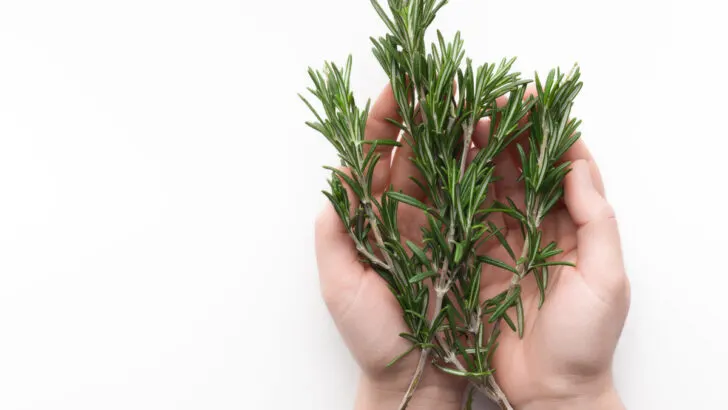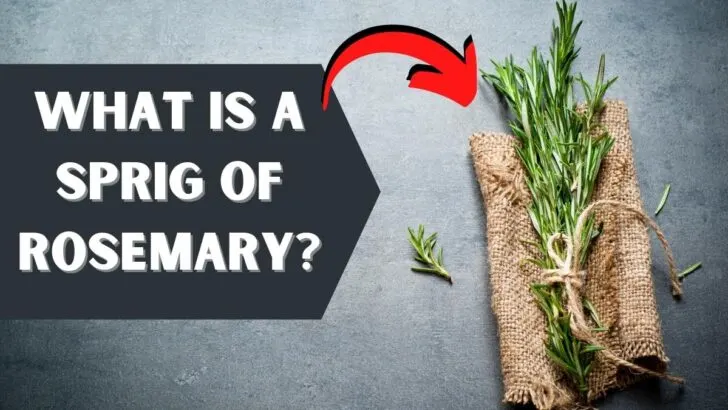Rosemary is a fragrant herb that adds flavor to many foods, including casseroles, soups, stews, and salads. Additionally, it pairs well with cereals, potatoes, spinach, mushrooms, and peas.
A sprig of rosemary is a single branch of rosemary. It extends no more than three inches from the plant’s terminal stem. It is ideal to use this part of the herb because it contains most of the flavor and smell.
Let’s dig into some nitty-gritty details of the substitutes of spring or rosemary and how you can use them!
Table of Contents
What Does One Sprig Of Rosemary Look Like?
Fresh rosemary sprigs resemble the needles of an evergreen tree in appearance.
One rosemary sprig extends no more than three inches from the plant’s terminal stem. Also, it is ideal to use this herb portion because it contains most of the smell and flavor.
However, you should be aware that this plant packs a powerful punch, so you may wish to wear gloves when you separate the leaves to avoid leaving your hands with an aftertaste.
To get the finest flavor, you should promptly use up all of the rosemary leaves. Actually, the leaves will bruise while removing them from the plant, releasing taste.
Remember not to use the lower leaves because as the plant ages, its flavor diminishes, and they may not be as pleasant to eat.
What Is A Sprig Of Rosemary Equal To?
What if you are out of fresh rosemary? Can you substitute it with dried rosemary?
Yes, you can. During the winter months, when fresh herbs may be hard to come by at your neighborhood supermarket, dried rosemary, which is widely accessible year-round, is a very good substitute.
You will require less dried rosemary because its flavor is stronger and more concentrated in that form.
However, how much dried rosemary should you use as a substitute for fresh rosemary?
It takes practice to determine how much dried rosemary to use in place of fresh rosemary when following a recipe, and ultimately, you should trust your taste buds.
The great news is that you may generally substitute dried rosemary with fresh rosemary by using the following general rule of thumb that 1 teaspoon of dried rosemary equals 1 tablespoon of fresh rosemary.
How Do You Cut A Sprig Of Rosemary?

Here is a simple method to cut a sprig of rosemary:
- The first step is to rinse fresh rosemary in a sink of cool water
- Put sprigs of rosemary in a strainer and rinse it properly since it is important to remove dirt from the herb
- Now, remove the excess moisture from the rosemary
- Spread out the rosemary and pat it dry. It is easier to cut dry rosemary because damp leaves will stick to each other
- Use one hand to grasp the sprig’s stem and use your index finger to cut off the leaves firmly
- Now, place the leaves on the cutting board or tabletop surface
- Once on the cutting board, make a tidy mound of leaves with the tips the same way and cut horizontally across the rosemary leaves
- If you do wind up slicing more rosemary than you need, you can keep the extra pieces for up to two weeks in a small jar or a sealable plastic bag.
Where To Buy Rosemary Sprigs
Dried rosemary can be found in the department of a supermarket store dedicated to spices.
Fresh rosemary is sometimes found in the produce area among other types of herbs.
It is typically offered in bunches or in little packets that only include a few sprigs at a time.
Common Substitutes For Rosemary
Be aware that the success of these alternatives will vary depending on the recipe and the method of rosemary application.
If you get the chance, you should get some right away!

1. Thyme
It is possible to use thyme in place of rosemary, despite the fact that its flavor is much less robust. If the recipe calls for fresh rosemary leaves to be used as a garnish on crostini or a salad, fresh thyme could be used instead with successful results.
You can use either dried or fresh thyme in place of fresh or dry rosemary in prepared recipes. The proportions should remain the same.
Unfortunately, it will have the flavor of thyme, but otherwise, it will be very similar to how the original recipe was supposed to turn out.
2. Marjoram or Savory
Because the flavors of marjoram and savory are similar to those of rosemary, you can use them as a substitute for rosemary if you do not have any on hand.
Because of the specialized nature of some herbs, it is possible that you do not currently possess any of them.
3. Sage
Sage can be used in place of rosemary since the two herbs share a flavor profile reminiscent of pine.
Sage is a highly potent herb; therefore, you should be careful you don’t use too much.
When fresh rosemary is called for as a garnish, sage leaves might be used instead.
When using sage in cooked meals, instead of rosemary, use one-half as much dried or fresh sage and adjust the flavor to your liking.
Final Words on Sprigs of Rosemary
A simple dish can be elevated to the level of gourmet experience with a sprig of rosemary. A wide variety of other fresh herbs work well in place of thyme and are also available easily.
They taste delicious, whether cooked or eaten raw, and appear particularly attractive when presented on the plate.


